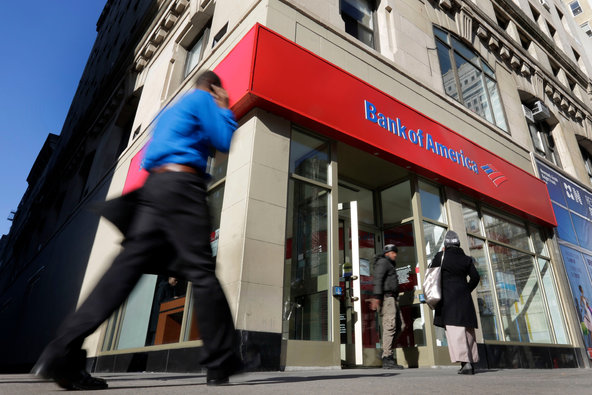 Richard Drew/Associated PressThe bank’s shares rose nearly 35 percent in the last year but fell almost 5 percent on Wednesday.
Richard Drew/Associated PressThe bank’s shares rose nearly 35 percent in the last year but fell almost 5 percent on Wednesday.
8:06 p.m. | Updated
Bank of America reported first-quarter earnings on Wednesday that fell well short of Wall Street’s expectations but that were substantially higher than in the period a year earlier.
The bank made 20 cents a share in the first quarter, compared with 3 cents in the year-earlier period. Analysts expected a profit of 23 cents a share. Bank of America, the nation’s second-largest lender by assets, had revenue of $23.5 billion in the first quarter.
Related Links
 Document: Earnings release
Document: Earnings release- Mortgage Crisis Lingers On at Citigroup and Bank of America (Jan. 17, 2013)
Since the financial crisis, Bank of America’s performance has been hurt by large mortgage-related losses, but in recent months investors have been betting that the bank would regain its footing. Its shares have risen nearly 35 percent in the last 12 months. Earlier this year, regulators approved the bank’s plan to buy back stock, a clear sign they felt that the lender was on firmer ground.
In a statement, Brian T. Moynihan, Bank of America’s chief executive, said, “Our strategy of connecting our customers to all we can do for them is working.”
The question now is how the latest earnings will affect the recent optimism surrounding the bank, which lends to individuals and companies and has a large Wall Street presence through its Merrill Lynch unit.
Other large banks have reported earnings that exceeded analysts’ estimates this quarter, so Bank of America’s failure to do so may unnerve some investors. The debate will be over whether the bank fell short because of deeper issues that will be hard to resolve or because of items that will have less of a negative effect as time passes. On Wednesday, the bank’s stock fell nearly 5 percent to close at $11.70.
Much uncertainty surrounds the cost of litigation over bad mortgages. Most of these troubled loans were made by Countrywide Financial, which Bank of America acquired in 2008. Bank of America has settled several big mortgage lawsuits, including one on Wednesday for $500 million, which was led by the Iowa Public Employees’ Retirement System. In the first quarter, Bank of America had litigation expenses of $881 million.
Some analysts wonder why the bank is still setting aside large amounts of money to cover mortgage lawsuits after reaching several settlements. “Maybe they haven’t been accruing enough for the outstanding litigation,” said Todd L. Hagerman, an analyst with Sterne Agee Leech.
In particular, analysts are focusing on a pending settlement with Bank of New York Mellon. The cost of this litigation, they say, could soar if the settlement does not gain court approval. A research note this year from Mike Mayo, an analyst with CLSA, suggested that the actual cost of the Bank of New York Mellon litigation could be as high as $30 billion, compared with the bank’s estimated cost of $8.5 billion.
The bank defended its litigation reserves.
“We believe we are appropriately reserved for the exposures we face, and we have provided investors with a range of possible loss estimates that could go beyond those reserves,” said Jerome F. Dubrowski, a spokesman for Bank of America.
Responding to the skepticism about the reserves against the Bank of New York litigation, he added, “We believe extrapolating selective rulings from other venues involving other litigants and facts and drawing conclusions about our settlements and other litigation matters does not portray a fair and accurate presentation of our litigation matters.”
The first-quarter results also revealed a mixed performance in Bank of America’s current mortgage business. Initially, the bank did not participate in the mortgage refinancing boom as strongly as rivals like Wells Fargo. But in recent months it has jumped back in.
In the first quarter, Bank of America originated $23.9 billion of mortgages, well up from $15.2 billion a year earlier. But revenue from writing new mortgages actually fell to $815 million from $928 million in the period a year earlier. This shows that profit margins in the new mortgage business have fallen as Bank of America has increased its activity.
The quarter contained bright spots for shareholders. The bank said it made headway in cutting expenses, something investors are watching closely.
In addition, Bank of America set aside significantly less money for its reserve against bad loans, which helped earnings.
Its wealth management unit, which includes the Merrill Lynch brokerage house, had a strong quarter. Revenue in the unit rose to $4.4 billion a year earlier.
While Bank of America’s earnings per share increased a lot when measured using generally accepted accounting principles, it declined on another measure that investors often look at. This nonstandard metric excludes arcane accounting charges. Without those charges in the first quarter of 2012, the bank made 31 cents a share.
This year’s first quarter contained little effect from such charges, so the 20 cents a share the bank reported on Wednesday should be compared with the 31 cents a share from the period a year earlier. In effect, under this approach, Bank of America’s earnings fell more than a third.
Article source: http://dealbook.nytimes.com/2013/04/17/bank-of-america-earnings-rise-but-fall-short-of-forecasts/?partner=rss&emc=rss